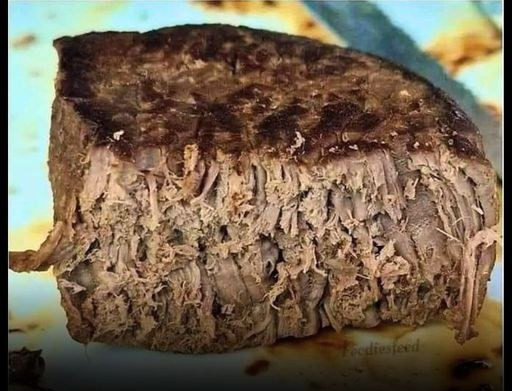
ADVERTISEMENT
A Surprising Steak: When Visuals Challenge Expectations
The culinary world is full of surprises, often blurring the lines between expectation and reality. When we think of steak, images of a perfectly seared, juicy cut of beef typically come to mind. We imagine the tender texture, the rich flavors, and the satisfaction of a well-prepared meal. However, the steak in the image you’ve shared challenges these conventional expectations and prompts an interesting reflection on how we perceive food.
The Power of First Impressions
First impressions are powerful, particularly when it comes to food. The visual appeal of a dish is a critical aspect of the dining experience, often setting the tone for how we expect it to taste. In the case of the steak in the image, the appearance is unconventional, to say the least. It looks more like a densely packed, shredded piece of meat than the typical steak we might envision. This unexpected presentation can evoke a variety of reactions, ranging from curiosity to skepticism.
What Is This Steak?
At first glance, this steak might remind some people of a type of meat that has been slow-cooked until it falls apart, similar to a pot roast or shredded beef. The texture appears fibrous and dense, which suggests that this steak has undergone a cooking process that has transformed its structure. The visible strands of meat might indicate that it was cooked for a long period, breaking down the connective tissues and resulting in a pull-apart consistency.
This kind of steak might have been prepared using a method like braising or slow roasting, where the meat is cooked slowly at a low temperature in a liquid. These methods are typically used to tenderize tougher cuts of meat, which might explain the appearance of the steak in the image.
The Expectations of Steak
When we think of steak, many of us imagine a well-marbled ribeye, a tender filet mignon, or a juicy sirloin. These cuts are often cooked quickly at high temperatures, either grilled or pan-seared, to develop a flavorful crust while maintaining a tender, pink interior. The contrast between the seared exterior and the juicy inside is what makes these steaks so appealing.
ADVERTISEMENT
The steak in the image, however, defies these expectations. Its appearance suggests a different kind of eating experience, one that might be more akin to a comfort food than a fine dining steak. The visual cues here lead us to imagine a texture that is more similar to pulled pork or brisket, where the meat has been cooked to the point of falling apart, rather than the tender but firm bite of a traditionally cooked steak.
The Role of Texture in Dining Experience
Texture is a critical component of how we enjoy food. It influences our perception of flavor and can make or break a dish. The steak in the image, with its shredded appearance, likely offers a texture that is soft, possibly even melt-in-your-mouth, depending on how it was prepared. This contrasts with the expected firmness and chewiness of a steak cooked to medium-rare on a grill.
For some, the texture of this steak might be a pleasant surprise, offering a different but equally enjoyable experience. For others, it might be disconcerting, as it doesn’t align with their preconceived notions of what a steak should be. This highlights the importance of managing expectations in cooking and the role that visual presentation plays in setting those expectations.
The Culinary Context: Exploring Different Cooking Techniques
The steak in the image invites us to explore different culinary techniques and the diverse ways in which meat can be prepared. While it doesn’t conform to the classic steakhouse image, it represents another facet of meat preparation that is deeply rooted in tradition and culture.
Braising, for example, is a technique that has been used for centuries to turn tougher cuts of meat into tender, flavorful dishes. It’s a method that’s particularly popular in comfort foods, where the emphasis is on deep, rich flavors and satisfying textures. The appearance of the steak in the image could be indicative of this type of preparation, where the goal is not a quick sear but a long, slow cooking process that transforms the meat.
ADVERTISEMENT
Conclusion: The Subjectivity of Culinary Expectations
The image of this steak challenges our culinary expectations and serves as a reminder that food is an art form with endless possibilities. It encourages us to think beyond the traditional and to appreciate the diversity of cooking methods that can produce different but equally enjoyable results.
At its core, this image highlights the subjectivity of food experiences. What might seem unappetizing to one person could be a beloved dish to another. It’s a reminder that our expectations are shaped by cultural norms, personal preferences, and past experiences, and that sometimes, it’s worth stepping outside of those expectations to discover something new.
So, the next time you come across a dish that doesn’t look quite like what you expected, consider giving it a try. You might just find that the unexpected becomes a new favorite, broadening your culinary horizons and enriching your dining experiences.
This article delves into the perception of food, exploring how visuals can challenge our expectations and inviting readers to consider the broader context of culinary experiences.
ADVERTISEMENT




